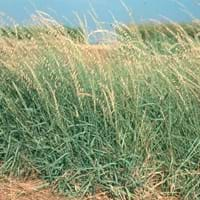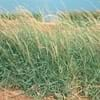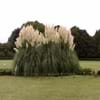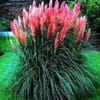Life Span
Perennial
Perennial
Type
Grass
Flowering Plants, Shrubs
Origin
North America, United States, Western United States, Southwestern United States, Mexico
Africa, America, Asia
Types
Grasses
Lockinch, Petite Indigo, White Profusion
Number of Varieties
Not Available
Habitat
Dry areas
Along Railroads, River side, Roadsides
USDA Hardiness Zone
3-9
5-10
Sunset Zone
1a, 1b, 2a, 2b, 3a, 3b, 7, 8, 9, 10, 11, 14, 18, 19, 20, 21
H1, 2a, 2b, 3a, 3b, 4, 5, 6, 7, 8, 9, 10, 11, 12, 13, 14, 15, 16, 17, 18, 19, 20, 21, 22, 23, 24
Habit
Clump-Forming
Arching/Fountain-shaped
Flower Color
White hair and some brown spots on margins and at tips
Blue, Pink, Purple, Red, White
Flower Color Modifier
Bicolor
Not Available
Fruit Color
Non Fruiting Plant
Not Available
Leaf Color in Spring
Green, Gray Green
Gray Green
Leaf Color in Summer
Light Green
Gray Green, Light Green
Leaf Color in Fall
Purple, Gray Green
Gray Green, Light Green, Yellow green
Leaf Color in Winter
Tan
Not Available
Leaf Shape
Grass like
Egg-shaped
Plant Season
Summer, Fall, Winter
Fall, Spring, Summer, Winter
Sunlight
Full Sun
Full Sun, Part sun, Partial shade
Type of Soil
Clay, Loam, Sand
Loamy, Sandy, Well drained
The pH of Soil
Neutral, Alkaline
Neutral, Slightly Acidic, Slightly Alkaline
Soil Drainage
Well drained
Well drained
Bloom Time
Summer, Late Summer
Spring
Tolerances
Pollution, Drought
Drought, Pollution, Salt, Soil Compaction
Where to Plant?
Ground
Ground, Pot
How to Plant?
Divison, Seedlings
Seedlings, Stem Planting, Transplanting
Plant Maintenance
Medium
Medium
Watering Requirements
Medium
Form a Soil ring to water efficiently, Water Deeply, Water twice a day in the initial period
In Summer
Lots of watering
Lots of watering
In Spring
Moderate
Moderate
In Winter
Average Water
Average Water
Soil pH
Neutral, Alkaline
Neutral, Slightly Acidic, Slightly Alkaline
Soil Type
Clay, Loam, Sand
Loamy, Sandy, Well drained
Soil Drainage Capacity
Well drained
Well drained
Sun Exposure
Full Sun
Full Sun, Part sun, Partial shade
Pruning
Remove damaged leaves, Remove dead branches, Remove dead leaves
Cut or pinch the stems, Prune for shortening long shoots, Prune if you want to improve plant shape, Prune ocassionally, Remove damaged leaves, Remove dead or diseased plant parts, Remove deadheads, Remove shoots
Fertilizers
All-Purpose Liquid Fertilizer
All-Purpose Liquid Fertilizer
Pests and Diseases
Beetles, Grasshoppers
Downy mildew, Leaf spot, Spider mites
Plant Tolerance
Drought
Drought
Flower Petal Number
Single
Single
Foliage Texture
Fine
Medium
Foliage Sheen
Matte
Matte
Attracts
Butterflies
Butterflies, Hummingbirds
Allergy
Not Available
Vomiting
Aesthetic Uses
Showy Purposes
Showy Purposes
Beauty Benefits
Not Available
Not Available
Environmental Uses
Air purification, Erosion control
Air purification
Medicinal Uses
Cuts
Not Available
Part of Plant Used
Leaves
Flowers, Leaves
Other Uses
Used to feed livestock
Showy Purposes, Used as Ornamental plant
Used As Indoor Plant
Sometimes
No
Used As Outdoor Plant
Yes
Yes
Garden Design
Dried Flower/Everlasting, Lawns and Turf, Mixed Border, Rock Garden / Wall
Edging, Feature Plant, Foundation
Botanical Name
BOUTELOUA gracilis
Buddleia davidii
Common Name
Blue Grama Grass, Mosquito Grass
Butterfly Bush, Summer Lilac, Butterflybush
In Hindi
Bouteloua gracilis
Butterfly Bush
In German
Bouteloua Gracilis
Schmetterlingsstrauch
In French
Bouteloua aristidoides
buisson de papillon
In Spanish
Chondrosum gracile
arbusto de las mariposas
In Greek
Bouteloua gracilis
Butterfly Μπους
In Portuguese
Bouteloua Gracilis
arbusto de borboleta
In Polish
Bouteloua Gracilis
Butterfly Bush
In Latin
Bouteloua Gracilis
papilio rubo
Phylum
Magnoliophyta
Spermatophyta
Class
Liliopsida
Dicotyledonae
Family
Poaceae
Scrophulariaceae
Clade
Angiosperms, Commelinids, Monocots
Angiosperms, Asterids, Eudicots
Tribe
Cynodonteae
Not Available
Subfamily
Chloridoideae
Not Available
Number of Species
Not Available
Importance of Bouteloua Gracilis and Butterfly Bush
Want to have the most appropriate plant for your garden? You might want to know the importance of Bouteloua Gracilis and Butterfly Bush. Basically, these two plants vary in many aspects. Compare Bouteloua Gracilis and Butterfly Bush as they differ in many characteristics such as their life, care, benefits, facts, etc. Every gardener must at least have the slightest clue about the plants he wants to plant in his garden. Compare their benefits, which differ in many ways like facts and uses. The medicinal use of Bouteloua Gracilis is Cuts whereas of Butterfly Bush is Not Available. Bouteloua Gracilis has beauty benefits as follows: Not Available while Butterfly Bush has beauty benefits as follows: Not Available.
Compare Facts of Bouteloua Gracilis vs Butterfly Bush
How to choose the best garden plant for your garden depending upon its facts? Here garden plant comparison will help you to solve this query. Compare the facts of Bouteloua Gracilis vs Butterfly Bush and know which one to choose. As garden plants have benefits and other uses, allergy is also a major drawback of plants for some people. Allergic reactions of Bouteloua Gracilis are Not Available whereas of Butterfly Bush have Vomiting respectively. Having a fruit bearing plant in your garden can be a plus point of your garden. Bouteloua Gracilis has showy fruits and Butterfly Bush has no showy fruits. Also Bouteloua Gracilis is not flowering and Butterfly Bush is flowering. You can compare Bouteloua Gracilis and Butterfly Bush facts and facts of other plants too.





